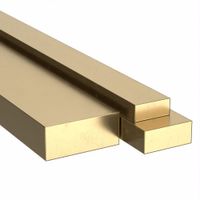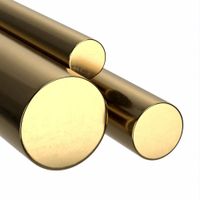Call +(254) 703 030 000 / 751 483 999 / 721 704 777
- Home
- Raw Materials
- Metals
- Brass
- Brass Bars Rods
.....Read More
Frequently Asked Questions
What are the main uses of brass bars and rods?
Brass bars and rods are widely used in various industries due to their excellent properties such as corrosion resistance, machinability, and aesthetic appeal. Here are the main uses:
1. **Manufacturing and Engineering**: Brass bars and rods are commonly used in the production of gears, bearings, and valves due to their low friction and wear resistance. They are also used in the manufacture of precision instruments and components that require tight tolerances.
2. **Plumbing and Heating**: Due to their corrosion resistance, brass rods are ideal for plumbing applications, including fittings, valves, and faucets. They are also used in heating systems for components like radiator valves and connectors.
3. **Electrical Applications**: Brass has good electrical conductivity, making it suitable for electrical components such as terminals, connectors, and switches. It is also used in the production of electrical contacts and battery terminals.
4. **Decorative and Architectural**: The aesthetic appeal of brass makes it a popular choice for decorative elements in architecture, such as railings, door handles, and light fixtures. It is also used in musical instruments like trumpets and trombones.
5. **Marine Applications**: Brass's resistance to saltwater corrosion makes it suitable for marine hardware, including propellers, shafts, and fasteners.
6. **Automotive Industry**: Brass rods are used in the automotive industry for components like radiator cores, fuel systems, and various fittings due to their durability and resistance to corrosion.
7. **Jewelry and Art**: Brass is often used in jewelry making and art due to its workability and attractive finish. It is used to create intricate designs and sculptures.
8. **Ammunition**: Brass rods are used in the production of ammunition casings due to their strength and ability to withstand high pressure.
These diverse applications highlight the versatility and importance of brass bars and rods across different sectors.
How do brass bars and rods resist corrosion?
Brass bars and rods resist corrosion primarily due to their composition and the formation of protective oxide layers. Brass is an alloy of copper and zinc, and sometimes includes small amounts of other elements like lead, tin, or aluminum. The copper content in brass plays a crucial role in its corrosion resistance. Copper naturally forms a thin, stable oxide layer when exposed to the atmosphere, which acts as a barrier to further oxidation and corrosion. This patina is often greenish or brownish and protects the underlying metal from environmental factors.
Zinc, the other primary component, also contributes to corrosion resistance. It forms its own protective oxide layer, which can enhance the overall durability of the alloy. The combination of copper and zinc in brass creates a synergistic effect, improving the alloy's resistance to various corrosive environments, including exposure to water, air, and certain chemicals.
Additionally, the presence of other alloying elements can further enhance corrosion resistance. For example, tin can improve resistance to dezincification, a form of corrosion where zinc is selectively leached from the alloy. Aluminum can form a protective aluminum oxide layer, adding another level of protection.
Brass's resistance to corrosion makes it suitable for a wide range of applications, including plumbing, marine environments, and decorative purposes. Its ability to withstand tarnishing and maintain structural integrity over time is a key reason for its widespread use in environments where corrosion resistance is critical.
What are the different grades of brass bars and rods?
Brass bars and rods are categorized into different grades based on their composition and properties, primarily determined by the ratio of copper to zinc and the presence of other alloying elements. Here are some common grades:
1. **C260 (Cartridge Brass):** Composed of approximately 70% copper and 30% zinc, this grade is known for its excellent ductility and strength, making it suitable for deep drawing and forming applications.
2. **C360 (Free-Cutting Brass):** Contains about 61.5% copper, 35.5% zinc, and 3% lead. The addition of lead improves machinability, making it ideal for high-speed machining operations.
3. **C385 (Architectural Bronze):** With around 60% copper, 38% zinc, and 2% lead, this grade offers good machinability and is often used in architectural applications due to its aesthetic appeal.
4. **C464 (Naval Brass):** Comprising 60% copper, 39% zinc, and 1% tin, this grade is known for its corrosion resistance, especially in marine environments, making it suitable for naval applications.
5. **C485 (Lead-Free Brass):** Contains about 77% copper, 21% zinc, and 2% bismuth. It is designed to be a lead-free alternative with good machinability and is often used in plumbing applications.
6. **C230 (Red Brass):** Also known as 85 metal, it consists of 85% copper and 15% zinc. It is known for its corrosion resistance and is used in applications like plumbing and electrical components.
7. **C280 (Muntz Metal):** Composed of 60% copper and 40% zinc, this grade is used for its strength and corrosion resistance, often in marine and industrial applications.
Each grade offers unique properties tailored to specific industrial needs, balancing factors like strength, corrosion resistance, machinability, and aesthetic appeal.
How do you machine brass rods effectively?
To machine brass rods effectively, follow these steps:
1. **Material Selection**: Choose the appropriate brass alloy, such as C36000 (free-machining brass), known for its excellent machinability.
2. **Tool Selection**: Use high-speed steel (HSS) or carbide tools with sharp cutting edges. Opt for tools with positive rake angles to reduce cutting forces and improve surface finish.
3. **Machine Setup**: Ensure the machine is rigid and well-maintained. Use appropriate workholding devices like collets or chucks to secure the brass rod firmly.
4. **Cutting Parameters**: Set optimal cutting speeds and feeds. Brass allows for high cutting speeds, typically between 150-300 m/min. Use moderate feed rates to balance surface finish and tool life.
5. **Coolant Use**: While brass can be machined dry, using a light oil-based coolant can improve surface finish and extend tool life by reducing heat and friction.
6. **Chip Control**: Ensure efficient chip evacuation to prevent re-cutting and tool damage. Use chip breakers or adjust feed rates to produce manageable chip sizes.
7. **Tool Maintenance**: Regularly inspect and replace tools to maintain sharpness and prevent workpiece damage. Dull tools can cause poor surface finish and dimensional inaccuracies.
8. **Quality Control**: Measure critical dimensions and surface finish using appropriate gauges and instruments to ensure the machined parts meet specifications.
9. **Safety Precautions**: Wear appropriate personal protective equipment (PPE) and ensure the workspace is clean and free of hazards.
By following these guidelines, you can achieve efficient and precise machining of brass rods, resulting in high-quality components with excellent surface finishes.
What are the advantages of using brass over other metals?
Brass, an alloy of copper and zinc, offers several advantages over other metals:
1. **Corrosion Resistance**: Brass is highly resistant to corrosion, especially from saltwater, making it ideal for marine and plumbing applications.
2. **Malleability**: It is more malleable than bronze or zinc, allowing for easier shaping and forming into intricate designs without cracking.
3. **Acoustic Properties**: Brass has excellent acoustic properties, making it the preferred material for musical instruments like trumpets and trombones.
4. **Aesthetic Appeal**: Its bright, gold-like appearance is visually appealing, making it popular for decorative items and architectural elements.
5. **Antimicrobial Properties**: Brass has natural antimicrobial properties, reducing the risk of bacterial growth, which is beneficial in healthcare settings and for door handles.
6. **Thermal Conductivity**: It has good thermal conductivity, making it suitable for heat exchangers and radiators.
7. **Electrical Conductivity**: While not as conductive as copper, brass still offers good electrical conductivity, useful in electrical components.
8. **Durability**: Brass is durable and can withstand high levels of wear and tear, making it suitable for applications like locks, gears, and bearings.
9. **Cost-Effectiveness**: Compared to pure copper, brass is more cost-effective while still offering many of the same benefits.
10. **Low Friction**: It has a low coefficient of friction, which is advantageous in applications requiring smooth movement, such as in valves and fittings.
11. **Recyclability**: Brass is easily recyclable, contributing to environmental sustainability.
These advantages make brass a versatile and valuable material across various industries, from construction and manufacturing to art and design.
How do you choose the right brass grade for a specific application?
To choose the right brass grade for a specific application, consider the following factors:
1. **Mechanical Properties**: Determine the required strength, ductility, and hardness. For high strength, consider C260 (Cartridge Brass) or C360 (Free-Cutting Brass). For better ductility, C272 (Yellow Brass) is suitable.
2. **Corrosion Resistance**: Assess the environment. For marine applications, C464 (Naval Brass) offers excellent corrosion resistance. For general corrosion resistance, C280 (Muntz Metal) is effective.
3. **Machinability**: If the application requires extensive machining, C360 (Free-Cutting Brass) is ideal due to its excellent machinability.
4. **Formability**: For applications requiring extensive forming, such as deep drawing, C260 (Cartridge Brass) is preferred due to its superior formability.
5. **Electrical Conductivity**: For electrical applications, C220 (Commercial Bronze) or C230 (Red Brass) are suitable due to their good electrical conductivity.
6. **Thermal Conductivity**: For heat exchangers, C280 (Muntz Metal) is often used due to its good thermal conductivity.
7. **Aesthetic Requirements**: For decorative purposes, consider C230 (Red Brass) or C280 (Muntz Metal) for their appealing color and finish.
8. **Cost**: Balance the material cost with performance requirements. C360 (Free-Cutting Brass) is often cost-effective for high-volume machining.
9. **Regulatory and Safety Standards**: Ensure compliance with industry standards and regulations, such as lead content restrictions for potable water applications.
10. **Availability**: Check the availability of the brass grade in required forms and sizes to ensure timely procurement.
By evaluating these factors, you can select the most appropriate brass grade that meets the specific demands of your application.
What are the common dimensions and sizes of brass flat bars?
Brass flat bars are available in a variety of dimensions and sizes to suit different applications. Commonly, these bars are measured by their width, thickness, and length.
Widths typically range from 1/4 inch (6.35 mm) to 6 inches (152.4 mm). Thicknesses can vary from 1/16 inch (1.59 mm) to 2 inches (50.8 mm). Standard lengths are often 6 feet (1.83 meters) or 12 feet (3.66 meters), but custom lengths can be ordered depending on the supplier.
In metric measurements, widths can range from 10 mm to 150 mm, with thicknesses from 2 mm to 50 mm. Lengths are usually available in 2-meter or 3-meter options.
Brass flat bars are often produced in standard alloys such as C36000, C38500, and C46400, each offering different properties like machinability, corrosion resistance, and strength. The choice of alloy and size depends on the specific requirements of the application, such as decorative trim, architectural components, or industrial parts.
These bars are typically available in mill finish, but they can also be polished or coated for enhanced appearance or protection. The versatility in size and finish makes brass flat bars suitable for a wide range of uses, from decorative to structural applications.

